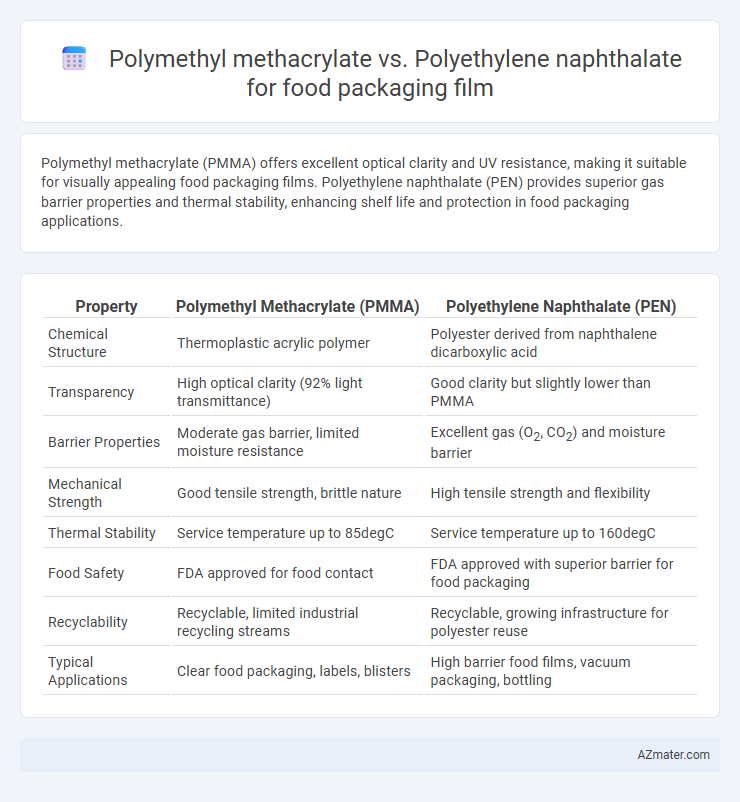Polymethyl methacrylate (PMMA) offers excellent optical clarity and UV resistance, making it suitable for visually appealing food packaging films. Polyethylene naphthalate (PEN) provides superior gas barrier properties and thermal stability, enhancing shelf life and protection in food packaging applications.
Table of Comparison
| Property | Polymethyl Methacrylate (PMMA) | Polyethylene Naphthalate (PEN) |
|---|---|---|
| Chemical Structure | Thermoplastic acrylic polymer | Polyester derived from naphthalene dicarboxylic acid |
| Transparency | High optical clarity (92% light transmittance) | Good clarity but slightly lower than PMMA |
| Barrier Properties | Moderate gas barrier, limited moisture resistance | Excellent gas (O2, CO2) and moisture barrier |
| Mechanical Strength | Good tensile strength, brittle nature | High tensile strength and flexibility |
| Thermal Stability | Service temperature up to 85degC | Service temperature up to 160degC |
| Food Safety | FDA approved for food contact | FDA approved with superior barrier for food packaging |
| Recyclability | Recyclable, limited industrial recycling streams | Recyclable, growing infrastructure for polyester reuse |
| Typical Applications | Clear food packaging, labels, blisters | High barrier food films, vacuum packaging, bottling |
Introduction to Food Packaging Films
Polymethyl methacrylate (PMMA) and Polyethylene naphthalate (PEN) are critical materials in food packaging films due to their unique barrier properties and durability. PMMA offers excellent optical clarity and resistance to UV radiation, making it suitable for visible and premium packaging applications. PEN provides superior gas barrier performance and thermal stability, enhancing shelf life and preserving food quality in packaging solutions.
Overview of Polymethyl Methacrylate (PMMA)
Polymethyl Methacrylate (PMMA) is a transparent thermoplastic known for its high clarity, excellent UV resistance, and good gas barrier properties, making it suitable for food packaging applications. PMMA offers superior optical properties compared to Polyethylene Naphthalate (PEN), enhancing product visibility and consumer appeal. Its rigidity and chemical resistance contribute to effective protection against contamination and extend the shelf life of packaged foods.
Overview of Polyethylene Naphthalate (PEN)
Polyethylene Naphthalate (PEN) is a high-performance polyester known for its superior barrier properties against oxygen and moisture, making it ideal for food packaging films that require extended shelf life. Compared to Polymethyl Methacrylate (PMMA), PEN offers enhanced thermal stability and mechanical strength, allowing for better durability and resistance to deformation under heat. PEN's excellent clarity and chemical resistance contribute to maintaining food quality and safety while providing a sustainable alternative with improved recyclability.
Barrier Properties: PMMA vs PEN
Polymethyl methacrylate (PMMA) offers moderate barrier properties against oxygen and moisture, making it suitable for general food packaging applications that require clarity but less demanding barrier performance. Polyethylene naphthalate (PEN) exhibits superior gas barrier characteristics compared to PMMA, with significantly lower oxygen and water vapor transmission rates, enhancing the shelf life of perishable food products. PEN's crystalline structure and chemical composition contribute to its enhanced barrier efficiency, making it a preferred choice for high-performance food packaging films requiring long-term preservation.
Mechanical Strength and Durability Comparison
Polymethyl methacrylate (PMMA) offers excellent mechanical strength with high tensile strength and rigidity, making it resistant to impact and deformation in food packaging films. Polyethylene naphthalate (PEN) surpasses PMMA in durability due to its superior thermal stability, chemical resistance, and barrier properties against gases and moisture, extending food shelf life. While PMMA provides clarity and stiffness, PEN delivers enhanced mechanical endurance and long-term performance under varying environmental conditions.
Optical Clarity and Transparency in Packaging
Polymethyl methacrylate (PMMA) exhibits exceptional optical clarity and high light transmittance, making it ideal for transparent food packaging films that enhance product visibility. Polyethylene naphthalate (PEN), while offering good transparency, typically has slightly lower optical clarity compared to PMMA but provides superior barrier properties against gases and moisture. The choice between PMMA and PEN for food packaging films depends on balancing transparency requirements with protective functionalities, where PMMA excels in visual presentation.
Thermal Stability and Heat Resistance
Polymethyl methacrylate (PMMA) exhibits moderate thermal stability with a glass transition temperature around 105degC, making it suitable for food packaging applications requiring clear, rigid films but limited heat resistance. Polyethylene naphthalate (PEN), with a higher glass transition temperature near 120-130degC and superior thermal stability, offers enhanced heat resistance ideal for packaging that demands prolonged exposure to elevated temperatures or thermal sterilization. PEN's crystallinity and lower oxygen permeability also contribute to better performance under thermal stress compared to PMMA, making it a preferred choice for high-temperature food packaging films.
Food Safety and Regulatory Compliance
Polymethyl methacrylate (PMMA) and Polyethylene naphthalate (PEN) are commonly used in food packaging films, with PMMA offering excellent clarity and chemical resistance, crucial for maintaining food safety by preventing contamination. PEN exhibits superior barrier properties against oxygen and moisture, enhancing shelf life and complying with stringent food safety regulations such as FDA and EFSA standards. Both materials are approved for food contact applications, but PEN's enhanced barrier performance often makes it the preferred choice for sensitive food products requiring extended preservation.
Environmental Impact and Recyclability
Polymethyl methacrylate (PMMA) exhibits lower environmental impact due to its biodegradability and ability to be chemically recycled, making it a favorable choice for sustainable food packaging films. In contrast, Polyethylene naphthalate (PEN) offers high barrier properties and thermal stability but poses challenges in recyclability because of limited industrial recycling infrastructure. Considering lifecycle assessments, PMMA-based films tend to reduce waste accumulation and carbon footprint compared to PEN, which often requires specialized recycling processes.
Cost Analysis and Market Applications
Polymethyl methacrylate (PMMA) offers superior clarity and UV resistance but comes at a higher cost compared to Polyethylene naphthalate (PEN), which is more economical and provides excellent barrier properties for gases and moisture. PEN is widely used in food packaging films for perishable items due to its durability and cost-effectiveness, while PMMA is preferred for premium applications requiring enhanced transparency and aesthetic appeal. Market trends show PEN dominating large-scale food packaging segments, whereas PMMA occupies niche markets where visual presentation justifies the increased expense.

Infographic: Polymethyl methacrylate vs Polyethylene naphthalate for Food packaging film
 azmater.com
azmater.com